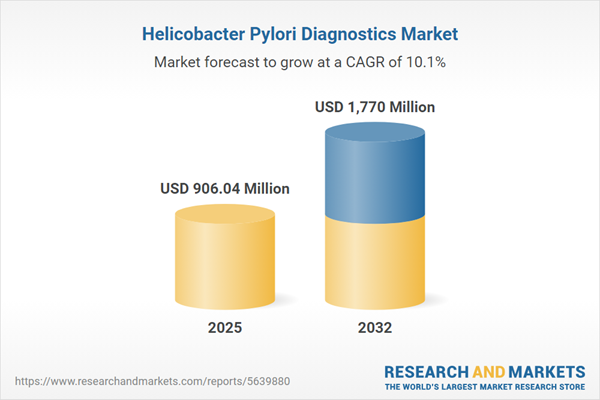Speak directly to the analyst to clarify any post sales queries you may have.
The Helicobacter pylori diagnostics market is advancing as healthcare leaders prioritize effective, precise, and adaptive solutions to meet changing clinical demands. Robust diagnostics frameworks are enabling organizations to strengthen workflows, support regulatory compliance, and optimize patient care quality.
Market Snapshot: Helicobacter pylori Diagnostics Market Growth
The global Helicobacter pylori diagnostics market is projected to grow from USD 822.28 million in 2024 to USD 906.04 million in 2025, representing a compound annual growth rate (CAGR) of 10.06%. By 2032, this market is estimated to reach USD 1.77 billion. Growth is being driven by the adoption of molecular diagnostic techniques and a clear industry shift toward noninvasive testing solutions, such as urea breath and stool antigen tests. Healthcare systems are reconfiguring clinical protocols and resource deployment in response to evolving reimbursement policies and regulatory requirements, fostering flexible diagnostic workflows tailored to current and future operational pressures.
Scope & Segmentation: Strategic Overview
- Test Types: Includes histological staining, molecular PCR diagnostics, rapid urease testing (C13 and C14 substrates), enzyme-linked immunosorbent assays, lateral flow assays, stool antigen tests, and urea breath analyses, serving a breadth of clinical needs from screening to acute intervention.
- Product Types: Encompasses PCR reagent kits, rapid urease and antigen detection kits, consumables for breath analysis, lateral flow strips, specialty chemicals, breath analyzers, immunoassay platforms, PCR equipment, and modern endoscopy units, which collectively drive efficiency from sample collection through result delivery.
- End Users: Solutions are established across ambulatory clinics, specialty centers, general and specialized hospitals, community health hubs, reference laboratories, and commercial diagnostic labs, designed for smooth integration with both centralized and decentralized care approaches.
- Technologies: Utilizes invasive and noninvasive diagnostic technologies, giving clinicians options such as histological analysis, traditional culture, molecular diagnostics, antigen and serological testing, stool-based diagnostics, and breath testing to fit diverse care settings and patient needs.
- Regions Covered: Spans North and South America (notably the US, Canada, Brazil, and Peru), Europe, the Middle East, Africa, and Asia-Pacific, allowing adaptation of strategies to regional regulatory pathways, infrastructure, and local innovation climates.
- Key Companies Analyzed: Features leading players such as F. Hoffmann-La Roche Ltd, Abbott Laboratories, Danaher Corporation, bioMérieux SA, Thermo Fisher Scientific Inc., Siemens Healthineers AG, DiaSorin S.p.A., Bio-Rad Laboratories Inc., Fujirebio Inc., and Sekisui Medical Co., Ltd., each recognized for product reliability, scientific expertise, and strong lifecycle management.
Key Takeaways: Strategic Insights for Senior Decision-Makers
- Molecular and isothermal amplification advances are raising laboratory accuracy standards and supporting more confident clinical decision-making in a broad range of care environments.
- Noninvasive diagnostic options such as urea breath and stool antigen testing are improving patient accessibility and helping simplify the care pathway for more efficient service delivery.
- Automated analyzer platforms and digital health solutions are fostering greater productivity in both centralized and distributed settings, bringing consistent results and scalability to diverse operational structures.
- Developing localized manufacturing and reinforcing supplier partnerships can reduce risks tied to shifting regulatory or supply conditions, while supporting long-term stability.
- Ongoing workforce development and regular software updates remain essential as diagnostic platforms advance, ensuring frictionless technology adoption and efficiency gains.
- Standardized procurement and adoption practices help support compliance and cost management by aligning organizational resource use with established protocols.
Tariff Impact: Managing Cost and Supply Challenges
Shifting tariff regulations are prompting healthcare providers to diversify their supply chains and expand local production capabilities. By strengthening supplier agreements, applying advanced procurement processes, and reinforcing contracts, organizations are prioritizing service consistency and cost management throughout the diagnostic cycle.
Methodology & Data Sources
All market insights are developed through in-depth interviews with sector leaders, systematic reviews of secondary sources, and assessment of operational, financial, and supply chain indicators. Data is independently validated by industry experts to ensure actionable and market-relevant findings for decision-makers.
Why This Report Matters
- Empowers executive teams to select and implement Helicobacter pylori diagnostics that enhance operational productivity and guide long-term business planning.
- Sheds light on the balance between regional compliance, regulatory changes, and evolving technical demands, supporting cost-effective procurement and solution alignment.
- Equips organizations to proactively adjust to shifting trends in the diagnostic landscape, supporting resilient and flexible strategies for future market movements.
Conclusion
Ongoing advancements in Helicobacter pylori diagnostics are supporting healthcare organizations in elevating care quality and operational efficiency. Senior leaders who apply these insights can foster organizational resilience and maintain performance in an evolving diagnostics marketplace.
Additional Product Information:
- Purchase of this report includes 1 year online access with quarterly updates.
- This report can be updated on request. Please contact our Customer Experience team using the Ask a Question widget on our website.
Table of Contents
3. Executive Summary
4. Market Overview
7. Cumulative Impact of Artificial Intelligence 2025
Companies Mentioned
The companies profiled in this Helicobacter Pylori Diagnostics market report include:- F. Hoffmann-La Roche Ltd
- Abbott Laboratories
- Danaher Corporation
- bioMérieux SA
- Thermo Fisher Scientific Inc.
- Siemens Healthineers AG
- DiaSorin S.p.A.
- Bio-Rad Laboratories, Inc.
- Fujirebio Inc.
- Sekisui Medical Co., Ltd.
Table Information
| Report Attribute | Details |
|---|---|
| No. of Pages | 191 |
| Published | November 2025 |
| Forecast Period | 2025 - 2032 |
| Estimated Market Value ( USD | $ 906.04 Million |
| Forecasted Market Value ( USD | $ 1770 Million |
| Compound Annual Growth Rate | 10.0% |
| Regions Covered | Global |
| No. of Companies Mentioned | 11 |









